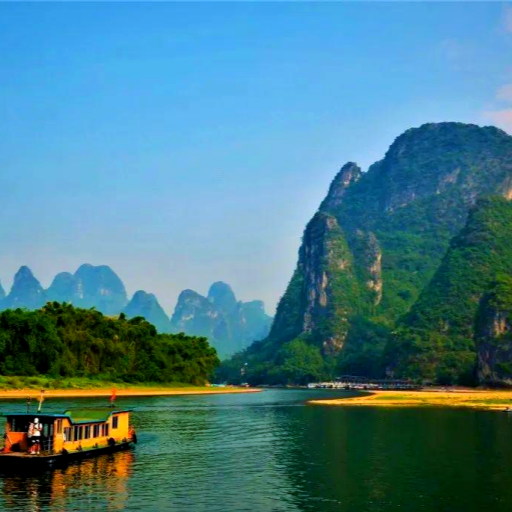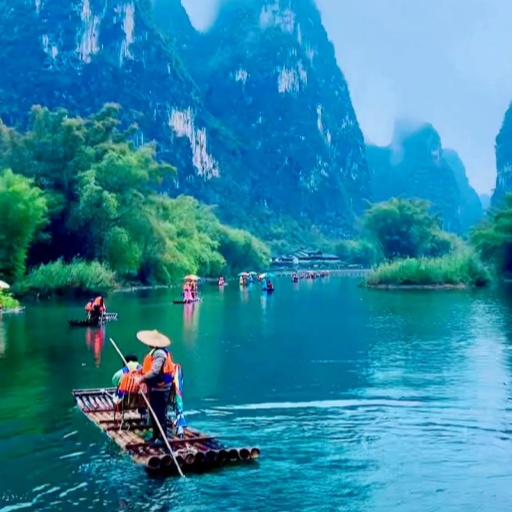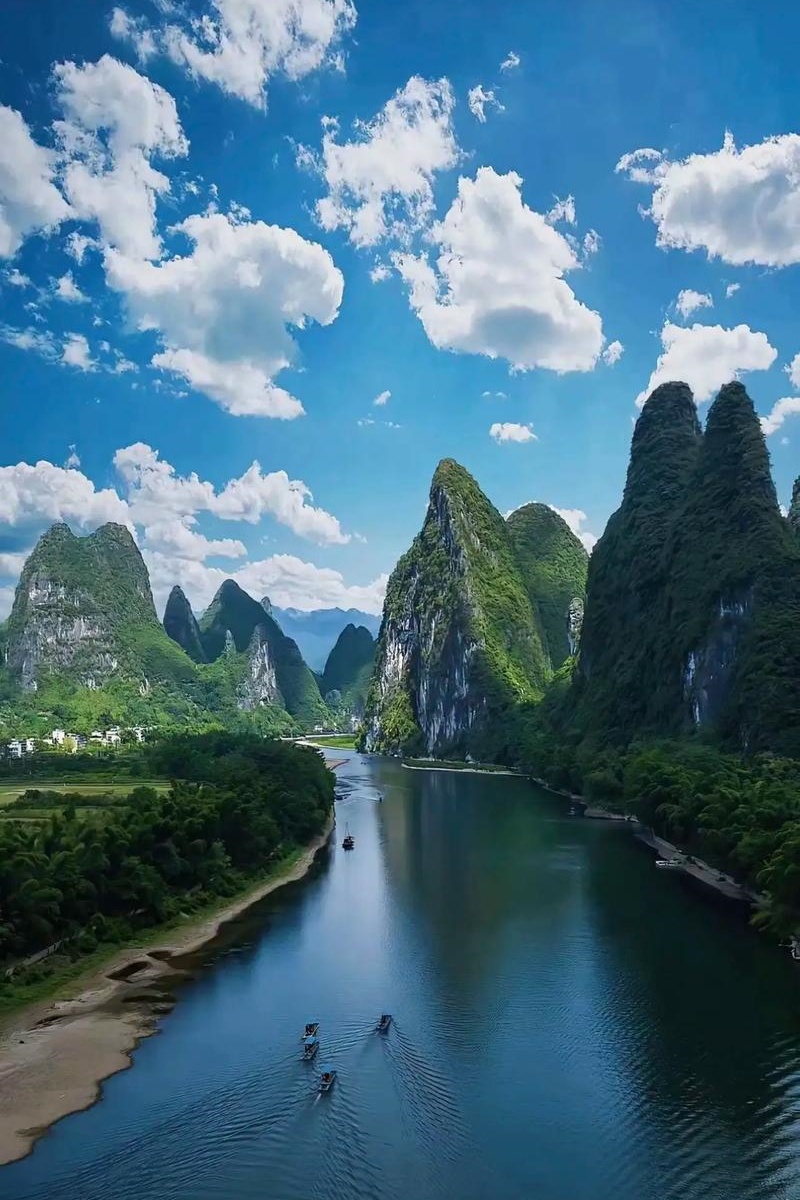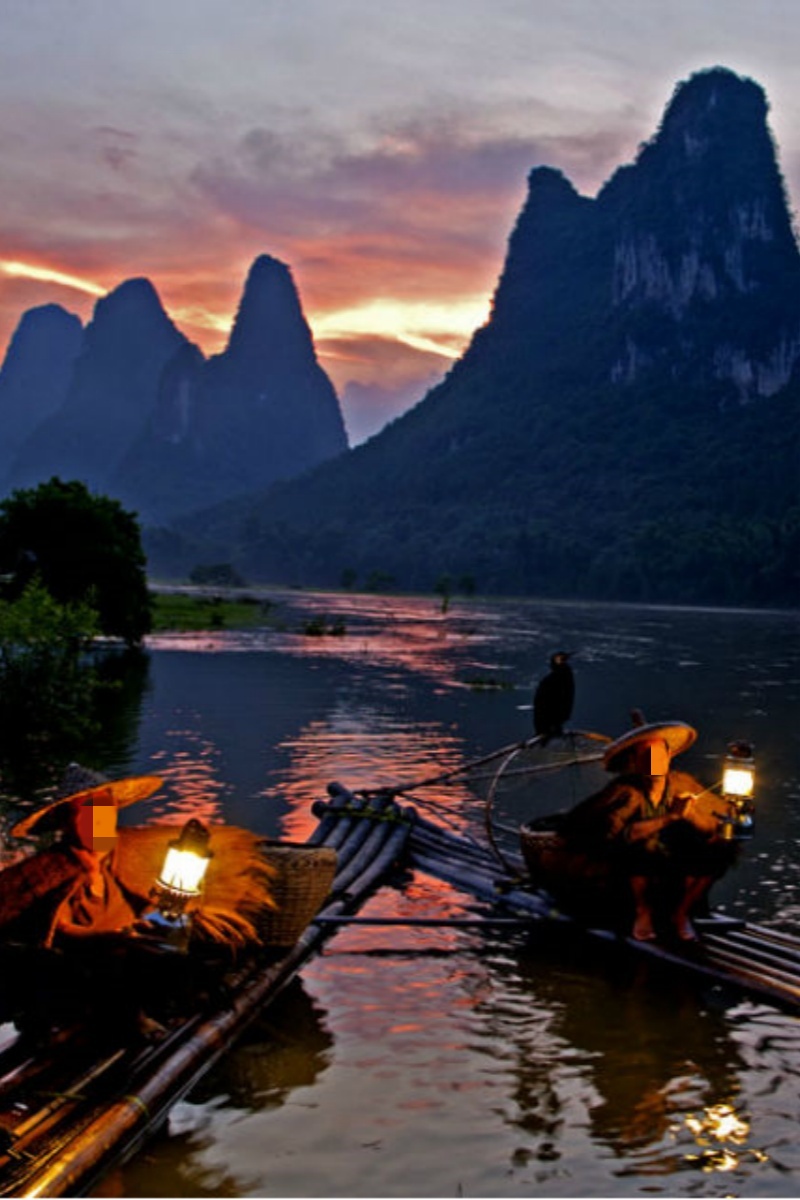The first time I saw the Li River near Yangshuo, it felt like walking into a scroll painting—but not a fake one. The sharp green peaks, the water curling like ink, the fog just sitting there… It wasn’t dramatic. It was quiet, but in a way that pulled you in. No filters, no setup. Just raw, strange beauty. Honestly, it made every landscape painting I'd ever seen make sense. Even the 20 yuan bill pays tribute to it.So what do you actually do once you’re here? That’s where it gets interesting. From bamboo rafting to hilltop sunrises, from quiet corners no one photographs to noodle stalls the guidebooks forget—Li River Yangshuo isn’t just something to look at. It’s something to move through, get lost in, maybe even get rained on a little. In this guide, I’ll walk you through the best routes, views, markets, and those odd little moments that stay with you long after your suitcase is back home.
What’s So Special About the Li River in Yangshuo?
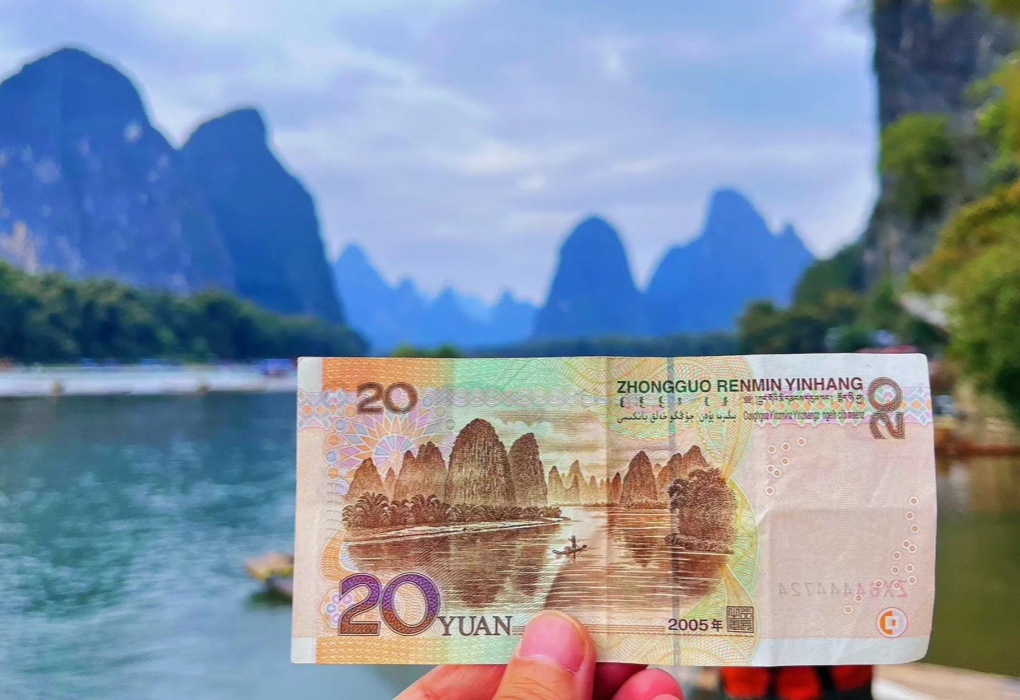
Li River on the 20 yuan bill
A Quick Look at the Li River in Yangshuo
You’ve probably never heard of the Li River—but you’ve seen it.Flip over a 20 yuan bill and there it is: misty peaks, quiet water, a curve that looks like it was drawn with a brush. That’s not just any place in China—that’s Yangshuo. And here’s the thing: that image isn’t edited. The real spot? Looks the same, just quieter. No filter, just fog. Most people say the Li River is famous, but it’s this one stretch near Yangshuo that people remember. Something about the way the light hits those karst hills—it just stays with you.
The entire river runs about 83 kilometers from Guilin to Yangshuo, but that’s just the geography. What makes the li river yangshuo stretch feel different is how alive it is. You’ll see bamboo rafts drifting past water buffalo, fishermen still using cormorants (yes, actual birds), and rice terraces climbing up steep hills. It's not just a sightseeing stop—it’s a full-blown scroll painting that moves.
What Locals Say About the Most Beautiful Stretch?
I once asked a tea seller at the Xingping pier if he ever got bored of the river. He didn’t even look up, just said, “Not this one.” He meant the Yangdi–Xingping stretch, and I get it now. It’s quiet in the mornings—like eerily quiet. No buses, barely any motorboats. Just soft water and that weird echo you only hear near cliffs.
Locals here love moments, not just views. Some say come after summer rain, when the clouds hang low like steam over a pot. Others prefer November, when the sun slants just right and the hills seem taller somehow. It’s hard to pin down. But they all say the same thing: this part of the li river yangshuo route makes you stop talking. You’ll be reaching for your camera and forget to click.
When Yangshuo’s limestone curves leave you hungry for deeper river myths, the next chapter flows through Discover Yangtze River — Beauty, Myths & Hidden Realities.
Best Ways to Travel the Li River from Guilin to Yangshuo
- Cruise Boats
- Bamboo Rafting
Cruise Boats—Slow, Comfortable, and Surprisingly Theatrical
Taking a Li River cruise from Guilin to Yangshuo is like watching a four-hour stage play where the set keeps changing, and the actors are mountains. The boat leaves from Zhujiang Pier or Mopanshan Pier, depending on the ticket you get. Both are about 20 km from Guilin city center, and unless you’ve booked through a tour agency, you’ll need to take a taxi—around ¥100 one way. If you book with a travel agency or your hotel, expect to pay about ¥35/person for pickup.
Zhujiang Pier has the nicer boats, no question. The so-called “super-luxury” ones have buffet lunches, panoramic windows, air conditioning, and even a rooftop deck where you can watch the river turn without getting up from your seat. The journey takes about 4.5 hours, and honestly, it doesn’t feel long. Not because it’s fast, but because this stretch of the Li River near Yangshuo has a way of hypnotizing you. People start quiet. By the end, they’re either asleep or glued to the window like it's a nature documentary.
If you're the kind of traveler who likes to just sit back and soak it all in, this is the move. No stress, no sunburn, and you get dropped off right at Yangshuo Pier, which is within walking distance of West Street and most hotels. You won't get the up-close river feel like with the bamboo rafts—but you’ll get the big picture, and for many, that’s enough.
Bamboo Rafting—Closer, Louder, and a Bit Wild
Alright, let’s talk motorized bamboo rafts. These ones are made of PVC tubes with an aluminum platform on top, powered by a back-mounted engine, and mostly run between Yangdi and Xingping—the most photogenic section of the li river yangshuo route. And yep, this is where the 20-yuan note view lives.
Rafts carry four passengers max, and the ride takes about 1.5 to 2 hours. It’s bumpy, loud, and way closer to the water than cruise boats. Some people love that—the splash in your face, the rumble of the motor, the chance to really see how clear the water is. Others? They kind of regret not wearing dry clothes. There’s no toilet, so go beforehand. And yes, ¥216 per person might feel steep, but hey, you’re basically renting a floating camera rig for an hour.
Once you hop off the boat in Xingping, it’s not over. You get ushered onto one of those little electric carts—they zip you over to the bus area. It’s kind of random, honestly, but it works. From there, you wait for a bus to Yangshuo, which usually takes about 30–40 minutes. The timing’s never perfect, but if you’re not in a rush, it’s fine. Just don’t expect signs or anyone telling you exactly where to go—you figure it out by watching what everyone else is doing. Just don’t expect peace and quiet. This is the “get in the action” version of the Li River Yangshuo trip, and it doesn’t pretend to be anything else.
Dry Season Detours—Alternate Routes When Water Runs Low
Between January and March, water levels can get weird. Some years it’s fine, other times, boats can’t run the full Guilin–Yangshuo route. When that happens, you’ll probably be rerouted to a smaller loop starting from Yangdi, looping past Hua Mountain, and back. The pier is called Shangzha Pier, and while the name’s a mouthful, the views still deliver.
This route lasts about 2.5 to 3 hours, and boats usually leave at 10:00 or 10:40 AM. If you're staying in Guilin, buses to Yangdi Tour Park run regularly from 7:30 to 14:00, taking around 1–1.5 hours. From the park, you hop on an electric shuttle to the pier—it’s free if you have a cruise ticket. Not quite as long or famous as the full cruise, but for winter travelers, this is often the only realistic way to still get a taste of the Li River Yangshuo route.
Let’s be real—it’s not as jaw-dropping as the full journey, but fewer crowds, softer light, and that off-season quiet? For some of us, that’s when the river feels most real.
Li River Yangshuo Views You’ll Actually Remember
- Xianggong Hill
- Fisherman on a bamboo raft
Wake Up for the Li River Sunrise—Xianggong Hill Is Worth It
It’s early. It’s steep. It might be foggy. But if there’s one view on the Li River Yangshuo stretch you’ll regret missing, it’s the one from Xianggong Hill. This short, sweaty 20-minute climb gets you eye-level with clouds as they swirl around the limestone peaks, and the Li River below twists like a ribbon of silver. The sunrise doesn’t just light the landscape—it makes it feel alive.
Locals call it the “dragon spine” for a reason. Standing up there, you see how the river doesn’t flow—it coils. The best light hits between 5:30–6:30 a.m., and yes, you’ll share the moment with tripod-carrying photographers. Entry is ¥60, and taxis from Yangshuo take about 40 minutes. You can book sunrise transfers via Ctrip. It’s not a hidden spot—but it hits hard, every single time.
At Dusk or Dawn, the River Becomes a Painting—Thanks to the Cormorants
You’ve probably seen the photos—a fisherman on a bamboo raft, kerosene lamp glowing, cormorants perched and ready. The scene is iconic, almost myth-like. And it still happens, but only in a few places—Xingping is one of them. The practice is now semi-staged for photography, but it’s no less striking. And at dusk or dawn, the light turns the whole thing into a moving scroll.
Locals sometimes rent out their rafts and birds to photographers—around ¥100–200 per session, depending on time and setup. You’ll need to ask around Xingping pier or book through a photo guide. The best part? The birds don’t perform. They glide, dive, flap. Sometimes they just sit there doing nothing. That unpredictability makes it feel less like a show—and more like watching an old rhythm most of the world forgot.
Go to a Real Farmers’ Market—And Skip the Instagram Noodles
It’s easy to eat in Yangshuo without ever seeing real food being made. Most visitors stick to restaurants on West Street, where the menus are in five languages and the dumplings arrive too fast to be handmade. But if you wake up early and walk toward Pantao Road Market or Baisha rural fair, the tone changes. Here, locals haggle over live fish, old men inspect bundles of herbs, and there’s always someone selling way too many garlic stems out of a van.
One morning I saw a guy butcher a chicken with one hand while texting with the other. Gross? A bit. Real? Completely. There’s something grounding about seeing where food comes from, especially after days of watching sunset boat rides and calligraphy shops. Plus, you can grab freshly made rice noodles for about ¥5—no branding, no filters, just hot broth and a cracked bowl. Honestly? That beat most meals I had in town.
How to Plan a Li River Yangshuo Trip That Feels Truly Yours?
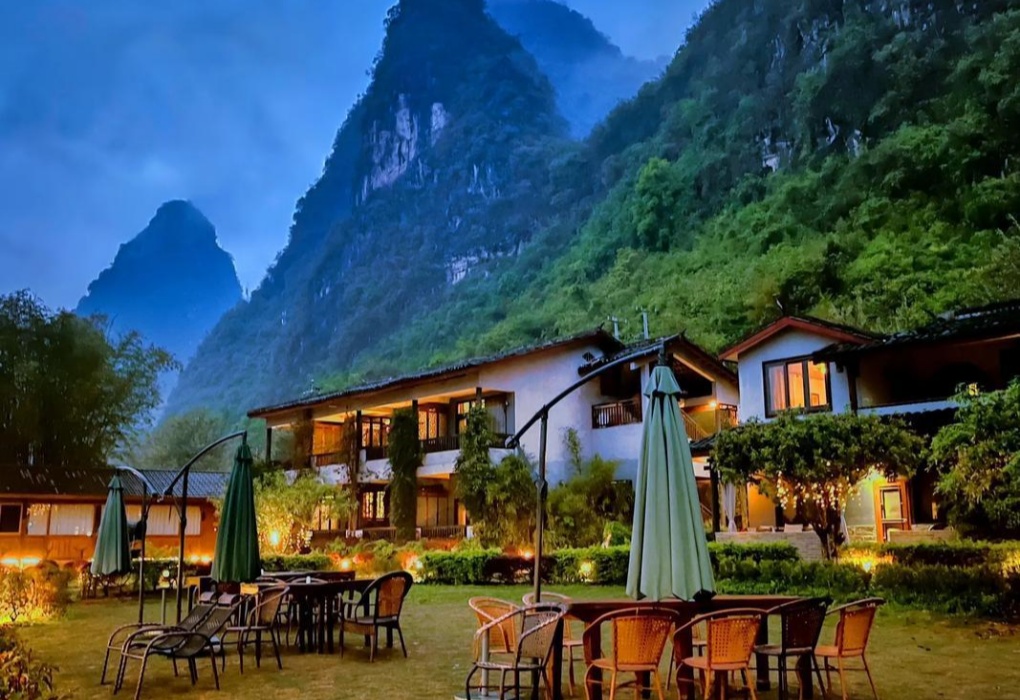
Li River Guesthouse
Pick a Place to Stay Where You Can Hear the River
Big mistake? Booking a room on West Street just because everyone else does. It's central, sure—but loud, crowded, and packed with overpriced smoothie shops. If you want your li river yangshuo trip to actually feel like you're in nature, look east—toward Shilihualang, Jima, or even along Yulong River. These spots have guesthouses and boutique hotels that accept foreigners, often run by young couples who speak some English and care more about views than foot traffic.
I stayed in a place where the balcony opened right onto the water. You could hear frogs at night and see the sunrise without leaving bed. Booking platforms like Ctrip or Agoda usually indicate if a place accepts foreign guests. Look for “可接待外宾” (can host foreigners), or just message the host directly. Some of these guesthouses even offer free e-bikes or private sunrise rides to Xianggong Hill, and I mean… try getting that from a chain hotel.
Don’t Let the Tour Groups Decide Your Timeline
Here's the thing: li river yangshuo is incredible, but it gets treated like a checklist. Cruise boat? Check. West Street snack? Check. Sunset photo? Check. But if you slow down just a bit, the trip shifts. Like, walk one stop past where the raft ends. Or say no to the group lunch and eat with the old couple making noodles behind their house. You don’t need to rebel—you just need to look sideways now and then.
When I skipped the “included lunch” on my bamboo raft package, the guide looked shocked. I walked into town, bought a pancake from someone’s mom, and sat by the river with no plan. That was the best hour I had. The trick is, let Yangshuo show itself to you, not the other way around. Skip a stop, take a wrong turn, linger too long. The river doesn’t care. It’ll still be there when you’re ready to look.
Beyond the Li River Yangshuo Experience—What Else Can You Actually Do?
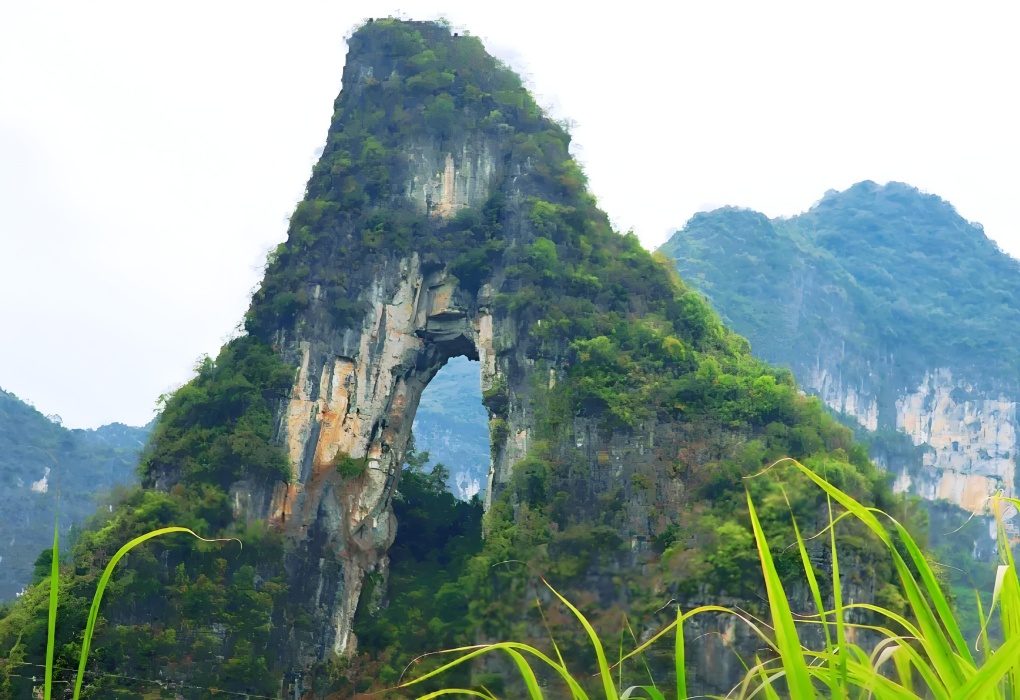
Hike Up to Moon Hill
Hike Up to Moon Hill—And Yes, There’s an Arch You Can Walk Through
So here’s something funny: everyone takes a photo of Moon Hill, but barely anyone climbs it. Maybe they think it’s too far (it’s not), or too touristy (also not). It’s a rough 800-step hike, but the trail winds through bamboo groves and citrus trees, and at the top—yep, you can actually stand inside the moon-shaped arch. It’s not huge, but it feels surreal looking through limestone and seeing pure sky.
Moon Hill is about 15 minutes from Yangshuo by scooter (easily rented for ¥30–50/day), and the entrance fee is ¥15–20 depending on the season. You’ll probably meet a couple of elderly women selling cold drinks—they’re harmless, just chatty. Best time to go? Late afternoon, when the sun hits the arch just right and the air cools down. It’s not the Li River, but it does make you feel like you’re standing inside a Chinese fable.
Catch an Outdoor Show—Where the River Becomes the Stage
If you want something totally different after a day on the river, go see Impression Liu Sanjie. It’s not a musical. It’s a water show directed by Zhang Yimou (yes, the Beijing Olympics guy), and it uses the actual Li River Yangshuo section as its backdrop—like, the mountains are the set. You’ll see hundreds of performers, light projections across water and stone, and a storyline loosely based on local Zhuang folklore.
It runs nightly (weather permitting) near Shili Hualang scenic zone, and tickets start around ¥238 (book via Ctrip or hotels). Bring bug spray and maybe a poncho—the seating is outdoors and sometimes gets damp. Touristy? Yes. Over-the-top? Definitely. But seeing the karst peaks lit up while a solo singer floats down the river? Kind of gives you chills, and you don’t even need to know what they’re singing about.
Frequently Asked Questions (FAQs)
Q: What’s the best time of year to visit the Li River in Yangshuo?
A: That depends on what you want. Most people say fall—October especially—is perfect. The weather stays dry, the skies are clear, and the rice paddies still glow yellow. But spring has its charm too. In April, you’ll often see mist hugging the river, which looks unreal. Locals call it "烟雨漓江"—like the river is breathing. I came in late June once. It was hot, yes, but also quiet. Fewer tour groups, more space to sit by the water. Just bring bug spray and don’t expect cold beer everywhere. I’d skip peak summer. July and August? Too humid. Also, Chinese school holidays bring in massive domestic crowds. It gets loud fast. If you want peace, go shoulder season. March, April, October, maybe even November. It’s still warm, and the river slows down. I always tell friends—avoid major Chinese holidays. Golden Week in October? Total chaos. You won’t even see the river through the tour buses. Honestly, pick a cloudy day. That’s when the river looks its best—like a scene from a scroll painting, not a travel ad.
Q: Can I take a swim in the Li River? A: Technically? Yes. Should you?
That’s trickier. The locals do swim sometimes. Mostly teenagers or old folks near the quieter bends. But it’s not officially allowed in many areas. There are signs. People ignore them. The water isn’t gross—but it’s not crystal clear either. It’s fine near Xingping and Fuli, where things slow down. But closer to the busy raft zones? Not ideal. Plus, the river current surprises you. It looks gentle, but some parts run fast under the surface. I jumped in once near a tiny pier at dawn. No one stopped me. A grandma nodded and laughed. But I kept my shoes on—there were broken tiles near the shore. You won’t find changing rooms or lockers, by the way. So if you swim, do it like the locals—quiet, quick, and with your clothes nearby. And no, no one's handing out towels. If you want a safer splash, head to a hotel with a pool. But if you’re the kind who likes breaking little rules, the river's tempting. Just pick your spot well. And maybe tell someone before you go.
Q: How can I avoid crowds at the most popular spots?
A: Simple trick—go early or go wrong. Most people follow the same routes: Yangdi to Xingping, then straight to West Street. That’s where it’s packed. But here’s what I do—I go to Xianggong Hill before sunrise, then head the opposite direction. Around 9 a.m., everyone’s still eating breakfast or checking out of hotels. That’s when the river paths are clear. Or take a bike toward Aishan or Putao. Fewer people go that way. Another trick? Avoid weekends. Chinese families pour in then. Even Tuesday feels different from Saturday. If you really want an empty view, go during lunch. Everyone’s inside. I once sat by a bend near Fuli for 40 minutes. Not one raft passed. You don’t need to go far. Just step off the marked path. The crowd sticks to maps. You don’t have to. Wear shoes you can get muddy. Say yes to the smaller turn-offs. And bring water. The quiet spots don’t sell bottles, but they’re worth every drop of sweat.
Q: Are there any night-time activities along the Li River worth trying?
A: Oh yes, but it’s not the kind of nightlife you get in Bangkok or Barcelona. This is quiet magic. Along the Li River in Yangshuo, nighttime means mist, cicadas, and boats with soft lights drifting by. One standout? The “Impression Liu Sanjie” light show. It’s staged right on the river, directed by Zhang Yimou—the guy behind the 2008 Olympics ceremony. Yeah, that guy. The show runs most nights, weather allowing. You sit on bleachers by the riverbank, watching performers glide across the water using real bamboo rafts, with the karst peaks lit up in the background. It’s surreal. Not cheap though—about ¥200–¥300, depending on seat class. Worth it? If you’ve never seen anything like it, yes. Also, you can walk the riverside trails at night. They’re lit, mostly safe, and nearly empty. I once brought a beer and just sat under a tree by the water for an hour. No music, no sales pitch, just the river doing its thing. Some nights, that’s all you need.
Q: Can I hike anywhere along the Li River, or is it all boats?
A: You can totally hike—some of the best parts are walkable. The trail between Xingping and Nine Horse Fresco Hill is a classic. It takes about two to three hours depending on your pace. The river’s on one side, rice paddies on the other, and the peaks follow you like sentinels. It’s mostly flat, sometimes muddy, always quiet. Tourists skip it because they go straight to boats. That’s their loss. You’ll pass local farmers, maybe a few goats, and probably one guy blasting music from a phone tied to his belt. It happens. Another solid stretch? Past Fuli. Not officially marked, but you can just follow the riverside path until it disappears. I like going there in late afternoon. The light softens, birds show up, and you’re alone except for a scooter or two. No ticket needed, no signs, just your feet and some water. Bring snacks. There’s no 7-Eleven, and no one’s selling coconuts here. But that’s the charm—it’s the river without a script.
Q: What are some underrated photo spots along the Li River in Yangshuo?
A: Everyone runs to Xianggong Hill, and yeah—it’s iconic. But if you want shots that don’t scream “postcard,” try Xingping Old Street at dawn. The stone alleyways get this golden glow when the sun hits the roof tiles. Plus, there’s often a guy selling steamed buns who doesn’t mind being photographed—if you buy one. Another overlooked spot? The riverside trail near Fuli Town. It’s super quiet. Banyan trees hang low over the water, and sometimes buffalo wander into frame like they know they’re majestic. My favorite though? A random pier I found near a village called Mushan. It’s not on maps. I went before sunset and just watched the colors shift on the water. No people, no signs, just me and a duck that refused to move. If you shoot on film, bring extra rolls. The misty light messes with exposure in the best way. These places don’t have platforms or signs—but maybe that’s what makes them perfect.
Want more China travel ideas? Check out our city guides on Beijing, Shanghai, Guangzhou, and Chengdu.
